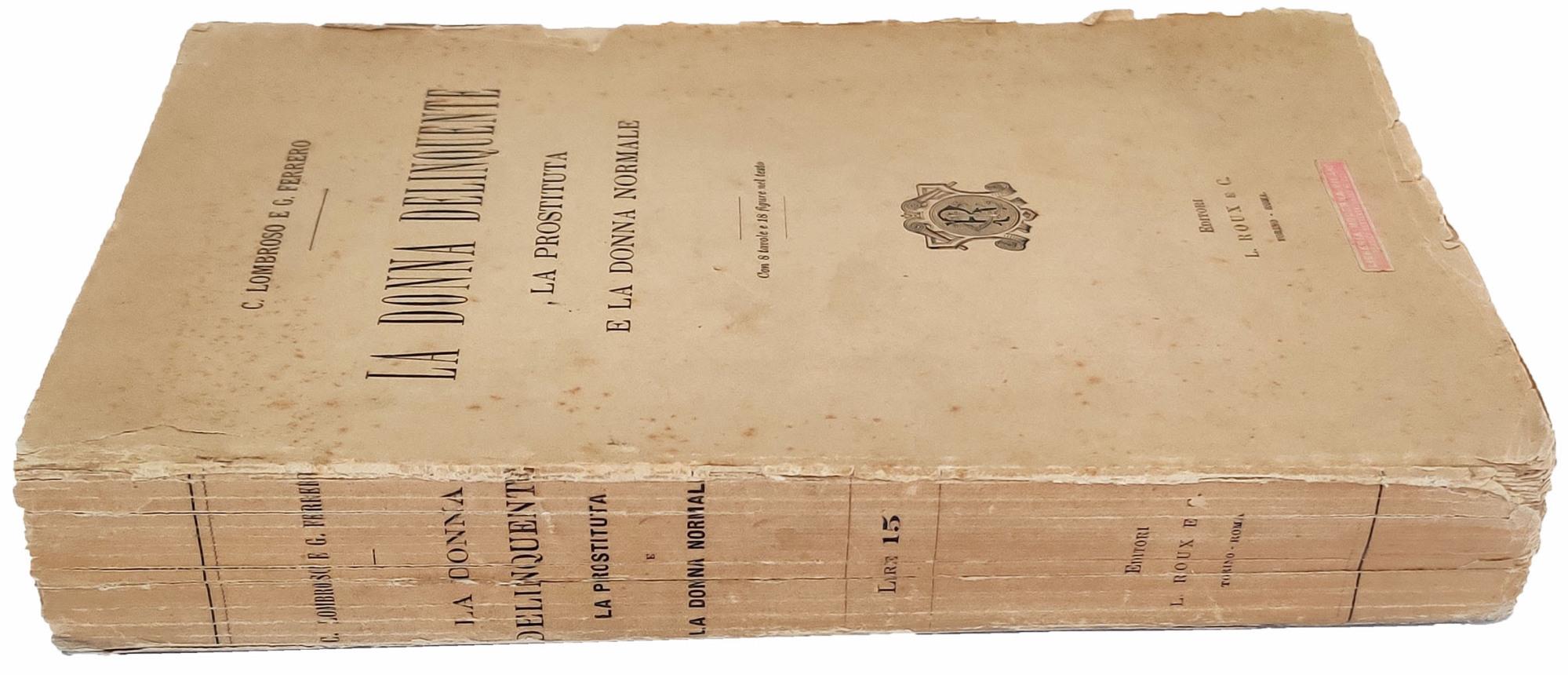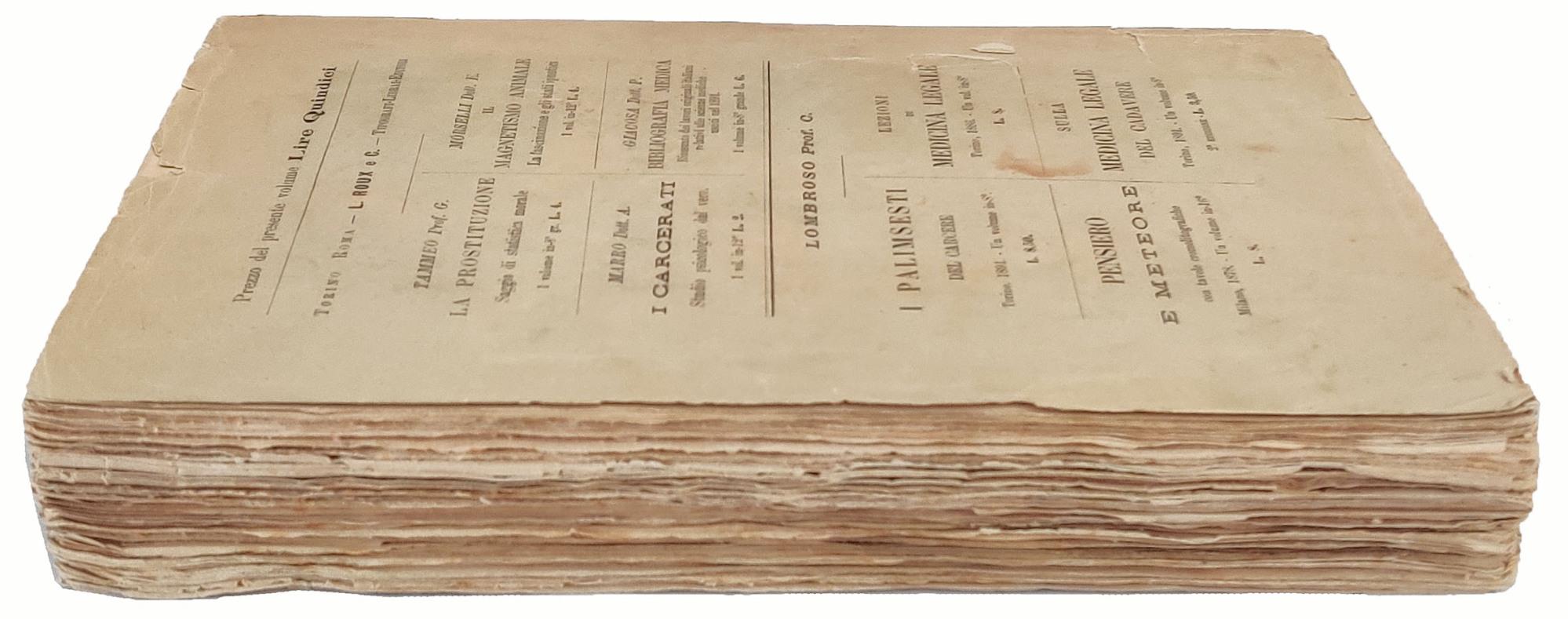La donna delinquente. La prostituta e la donna normale
THE CRIMINAL WOMAN - IN THE ORIGINAL PRINTED WRAPPERS
8vo (242x154 mm). XI, [1 blank], 640 pp. and 8 (4 folding) plates. The first leaf is a blank. With the engraved portrait of Messalina on the title page, and several diagrams, photographs and statistical tables in the text. Editor's printed wrappers (some foxing, spine fragile, occasional tears to the margins and to the back cover). On the front cover bookplate of the “Libreria Moderna-Milano”. An exceptional uncut copy preserved in a cardboard box.
Rare first edition of this very influential work on criminal woman, considered as the first modern criminology text to exclusively focus on the subject.
A first draft of the work, written in collaboration with Salvatore Ottolenghi, had appeared two years earlier in the “Giornale della R. Accademia di Medicina” (nos. 9-10). The final draft was written in collaboration with the author's son-in-law, the talented law student Guglielmo Ferrero.
In Criminal Woman, Lombroso applies to women the same theories expressed in his Uomo delinquente (‘Criminal Man'), published in 1876, the work that marks the foundation of criminal anthropology. In the text, he outlines a comparative analysis of “normal women” opposed to “criminal women” such as “the prostitute”.
Lombroso was convinced of the pathological nature of the born criminal (whom he distinguishes, medically and legally, from the casual offender who commits a crime driven by special circumstances or needs) and of the possibility of explaining and predicting moral degeneration from its physical abnormalities. According to Lombroso, there is a correlation between somatic and mental deformities with reference to specific factors as atavism, degeneration, and epilepsy. He believes that criminals are more often found to suffer from physical, nervous and mental abnormalities than non-criminals, and that these abnormalities are either inherited or the result of physical degeneration. Lombroso also deals with the legal implications of his theories, particularly in relation to the issue of “moral insanity”, understood as a serious disturbance of social behavior. He thus initiated a branch of psychiatric research which has cast new light on the complex problem of criminal responsibility (cf. M. Gibson, Born to Crime. Cesare Lombroso and the Italian origins of Biological Criminology, Westport, 2002, passim).
Lombroso was born in Verona in 1835 to a wealthy Jewish family. He studied literature, linguistics, and archaeology at the universities of Padua, Vienna and Paris, before becoming an army surgeon in 1859. In 1866 he was appointed visiting lecturer at Pavia and in 1871 he took charge of the insane asylum at Pesaro. He became professor of forensic medicine and hygiene at Turin in 1878. Later he was appointed as professor of psychiatry (1896) and criminal anthropology (1906) at the same university. He died in Turin in 1909 (cf. M.E. Wolfgang, Pioneers in Criminology: Cesare Lombroso (1835-1909), in: “The Journal of Criminal Law, Criminology, and Police Science”, 1961, 52.4, p. 361 ff.).
Italian Union Catalogue, IT\ICCU\UFI\0294209; Norman, 1384; G. Armocida, Lombroso, Cesare, in “Dizionario Biografico degli Italiani”, Rome, 2005, vol. 65, pp. 548-553; H. Mannheim, Pioneers in Criminology, London, 1960, pp. 168-227.
Venditore:

Informazioni:
<p>THE CRIMINAL WOMAN - IN THE ORIGINAL PRINTED WRAPPERS</p> <p>8vo (242x154 mm). XI, [1 blank], 640 pp. and 8 (4 folding) plates. The first leaf is a blank. With the engraved portrait of Messalina on the title page, and several diagrams, photographs and statistical tables in the text. Editor's printed wrappers (some foxing, spine fragile, occasional tears to the margins and to the back cover). On the front cover bookplate of the &ldquo;Libreria Moderna-Milano&rdquo;. An exceptional uncut copy preserved in a cardboard box.</p> <p>Rare first edition of this very influential work on criminal woman, considered as the first modern criminology text to exclusively focus on the subject.</p> <p>A first draft of the work, written in collaboration with Salvatore Ottolenghi, had appeared two years earlier in the &ldquo;Giornale della R. Accademia di Medicina&rdquo; (nos. 9-10). The final draft was written in collaboration with the author's son-in-law, the talented law student Guglielmo Ferrero.</p> <p>In <em>Criminal Woman</em>, Lombroso applies to women the same theories expressed in his <em>Uomo delinquente</em> (&lsquo;Criminal Man'), published in 1876, the work that marks the foundation of criminal anthropology. In the text, he outlines a comparative analysis of &ldquo;normal women&rdquo; opposed to &ldquo;criminal women&rdquo; such as &ldquo;the prostitute&rdquo;.</p> <p>Lombroso was convinced of the pathological nature of the born criminal (whom he distinguishes, medically and legally, from the casual offender who commits a crime driven by special circumstances or needs) and of the possibility of explaining and predicting moral degeneration from its physical abnormalities. According to Lombroso, there is a correlation between somatic and mental deformities with reference to specific factors as atavism, degeneration, and epilepsy. He believ
Immagini:




-
Autore:
-
Editore:
-
Tipologia:
-
Anno edizione:1893
- Prodotto usato
- Condizioni: Usato - Ottima condizione
Le schede prodotto sono aggiornate in conformità al Regolamento UE 988/2023. Laddove ci fossero taluni dati non disponibili per ragioni indipendenti da Feltrinelli, vi informiamo che stiamo compiendo ogni ragionevole sforzo per inserirli. Vi invitiamo a controllare periodicamente il sito www.lafeltrinelli.it per eventuali novità e aggiornamenti.
Per le vendite di prodotti da terze parti, ciascun venditore si assume la piena e diretta responsabilità per la commercializzazione del prodotto e per la sua conformità al Regolamento UE 988/2023, nonché alle normative nazionali ed europee vigenti.
Per informazioni sulla sicurezza dei prodotti, contattare productsafety@feltrinelli.it



